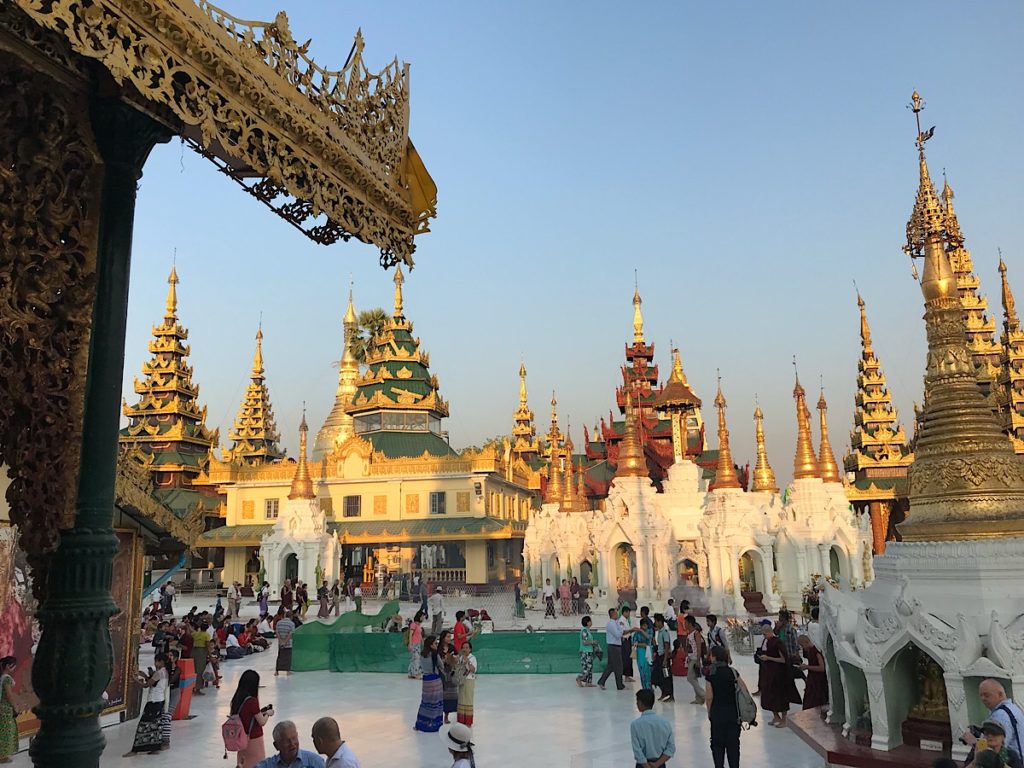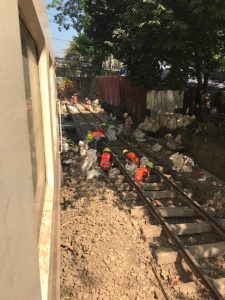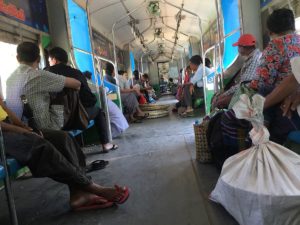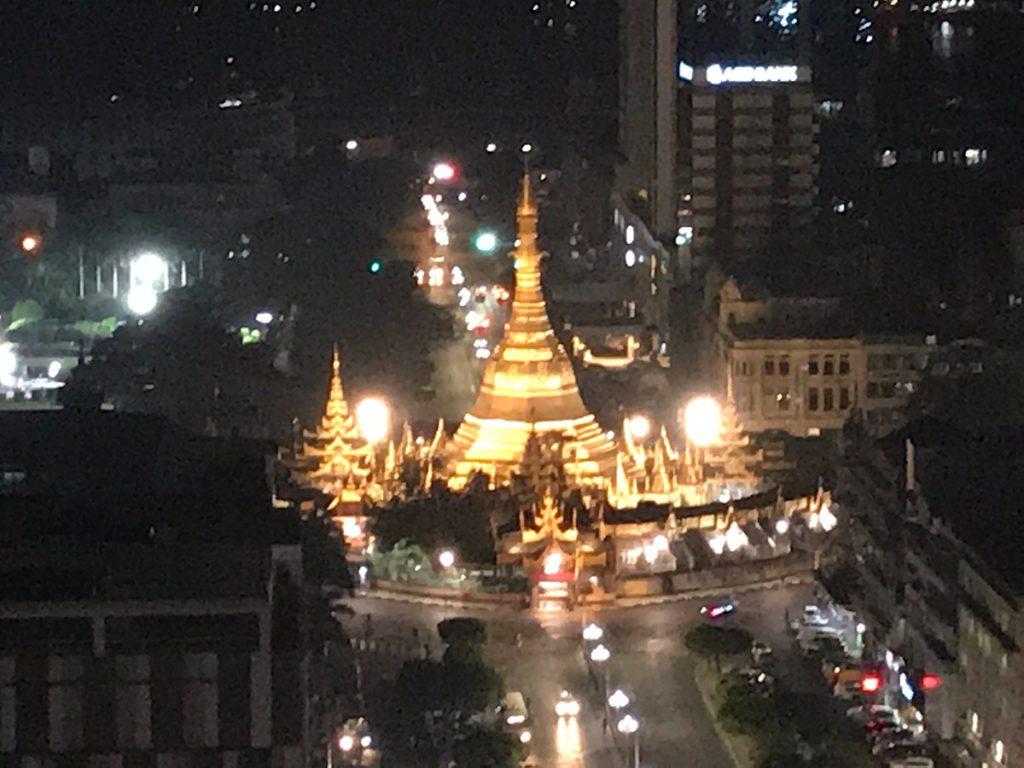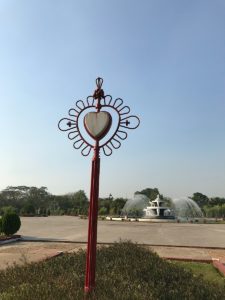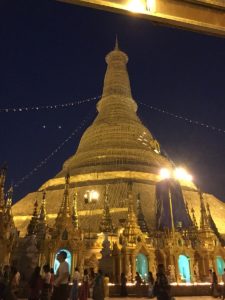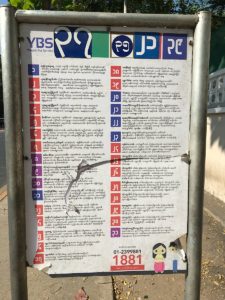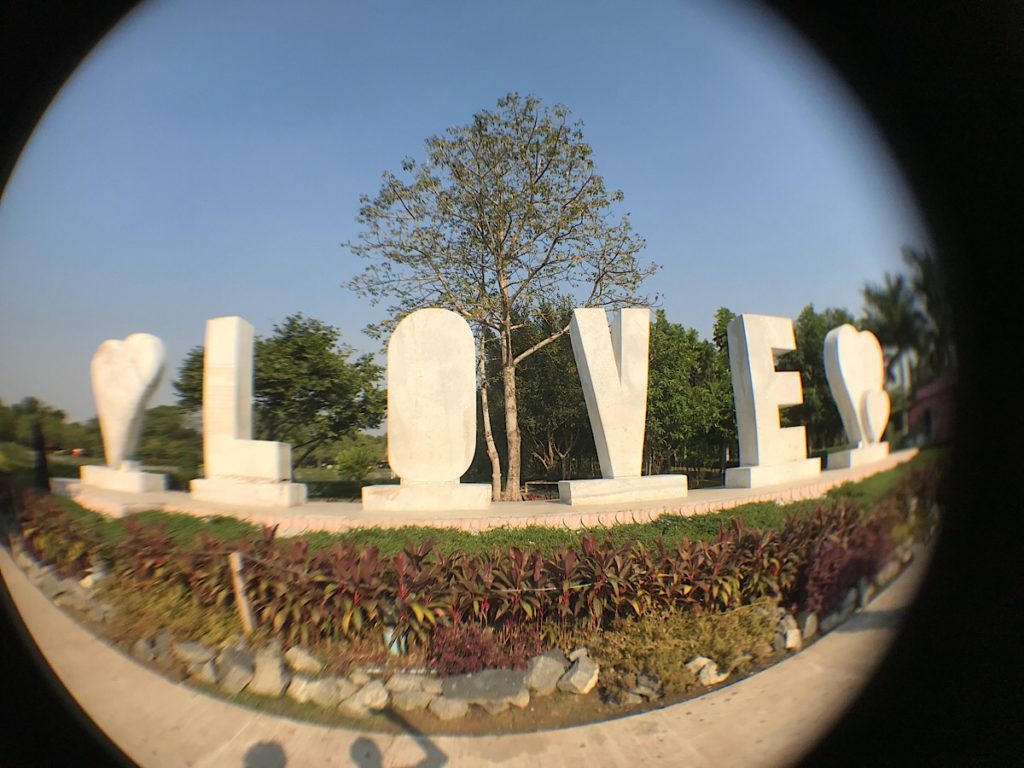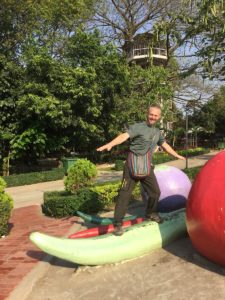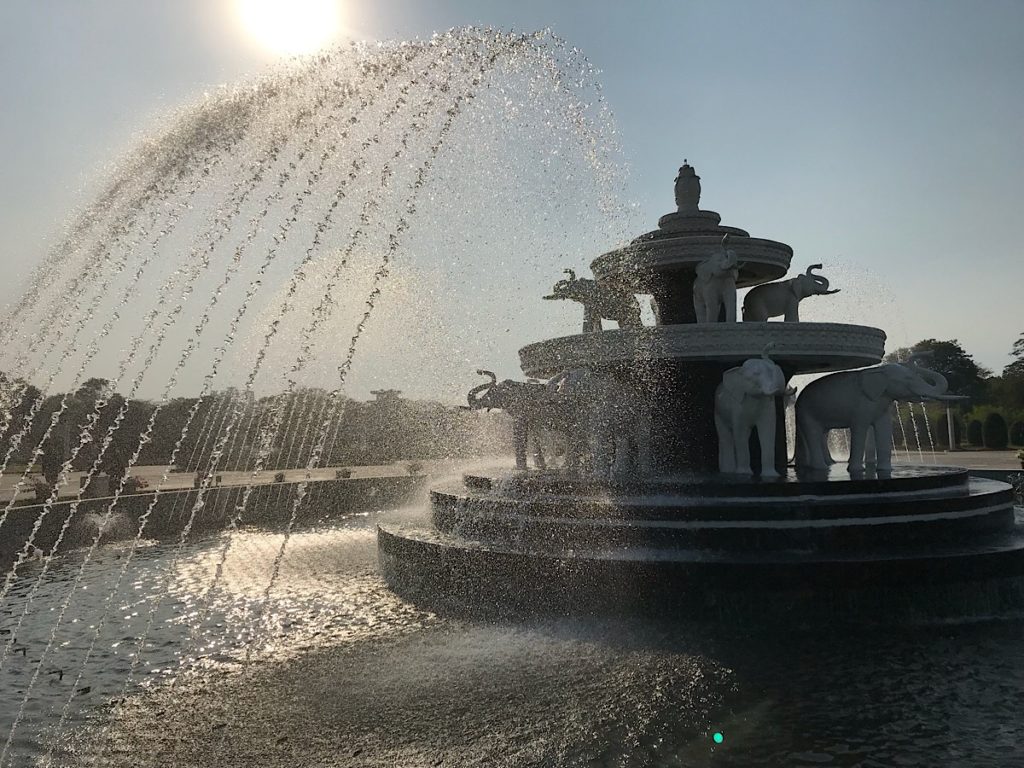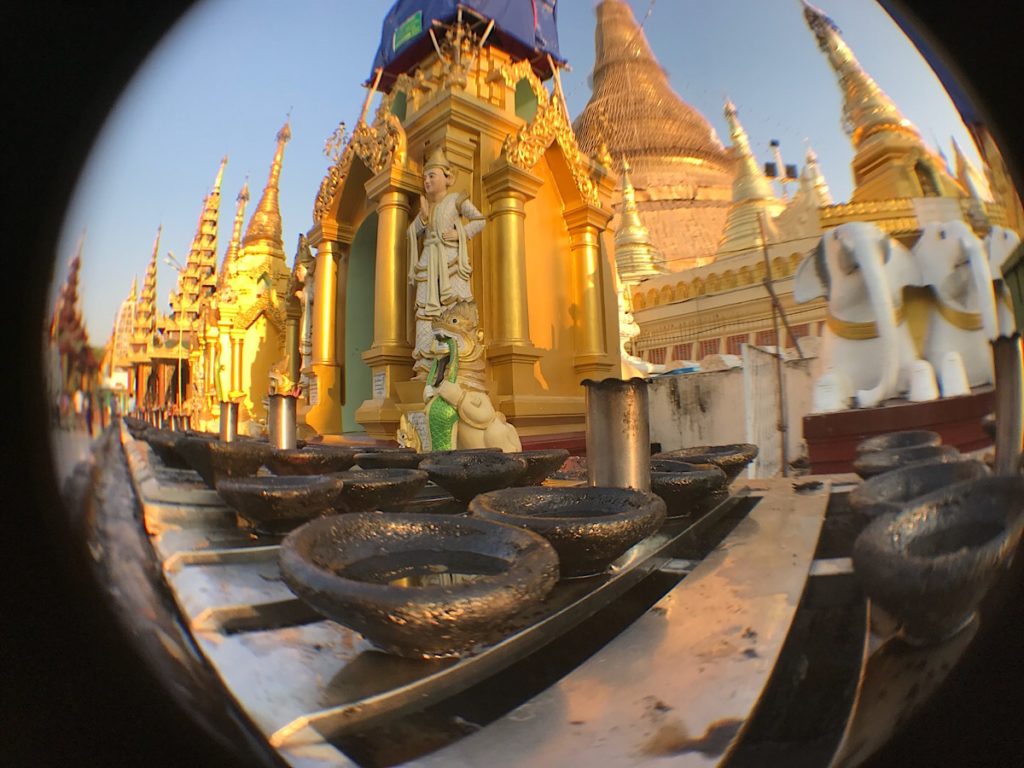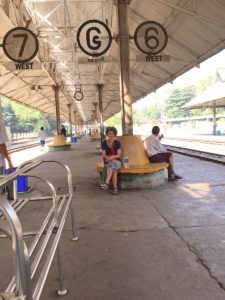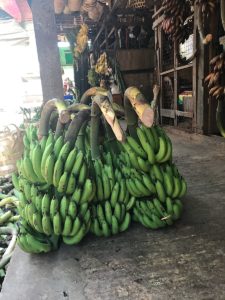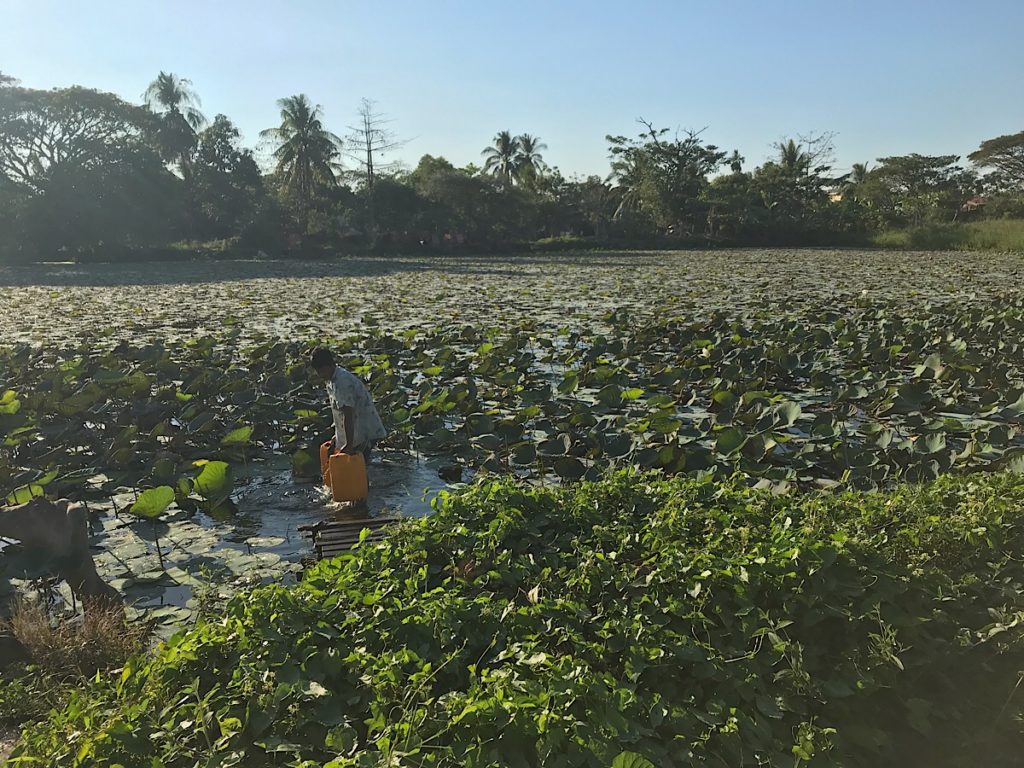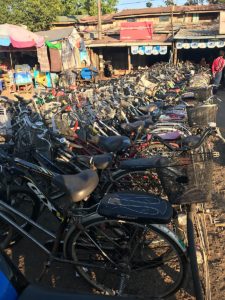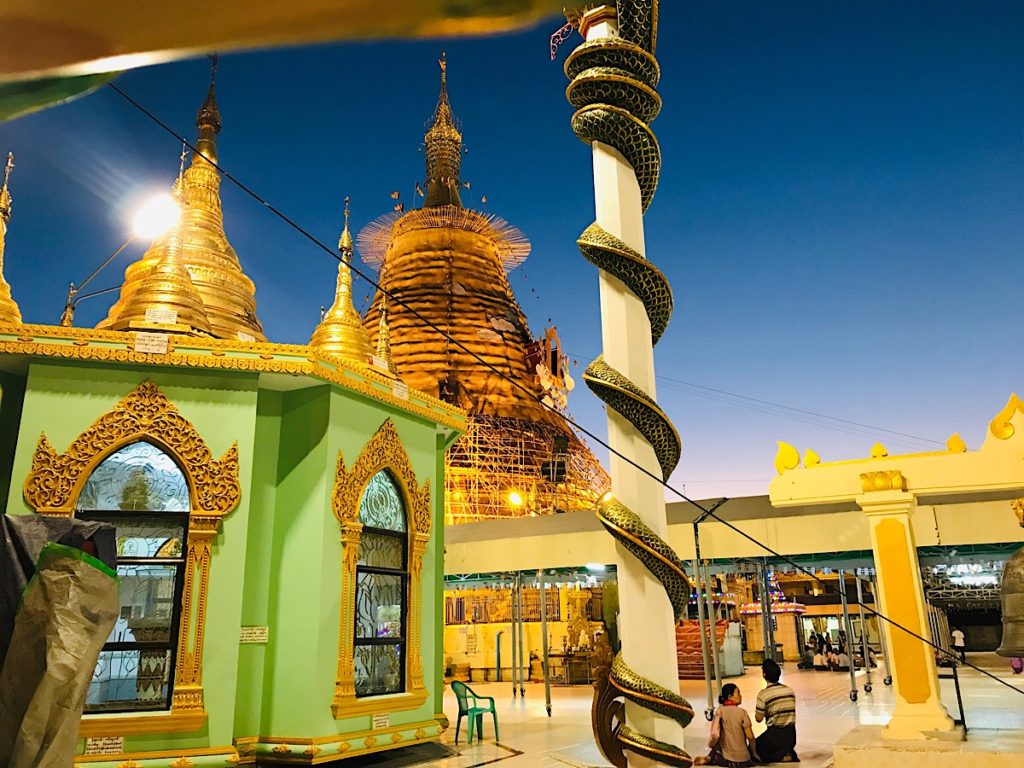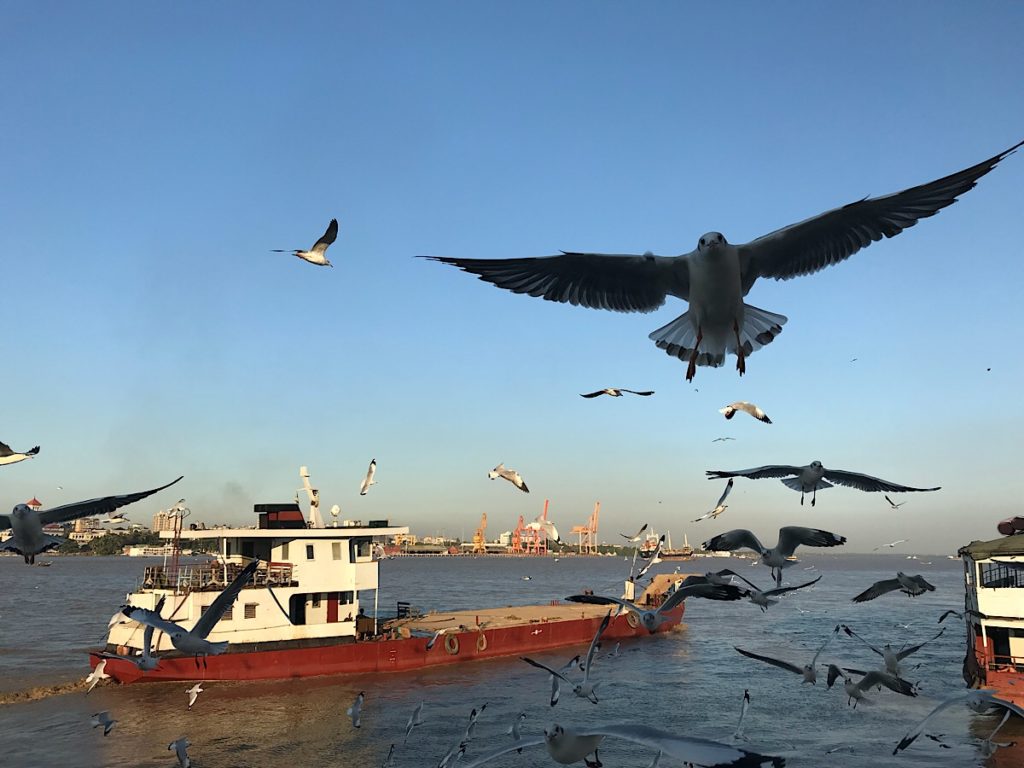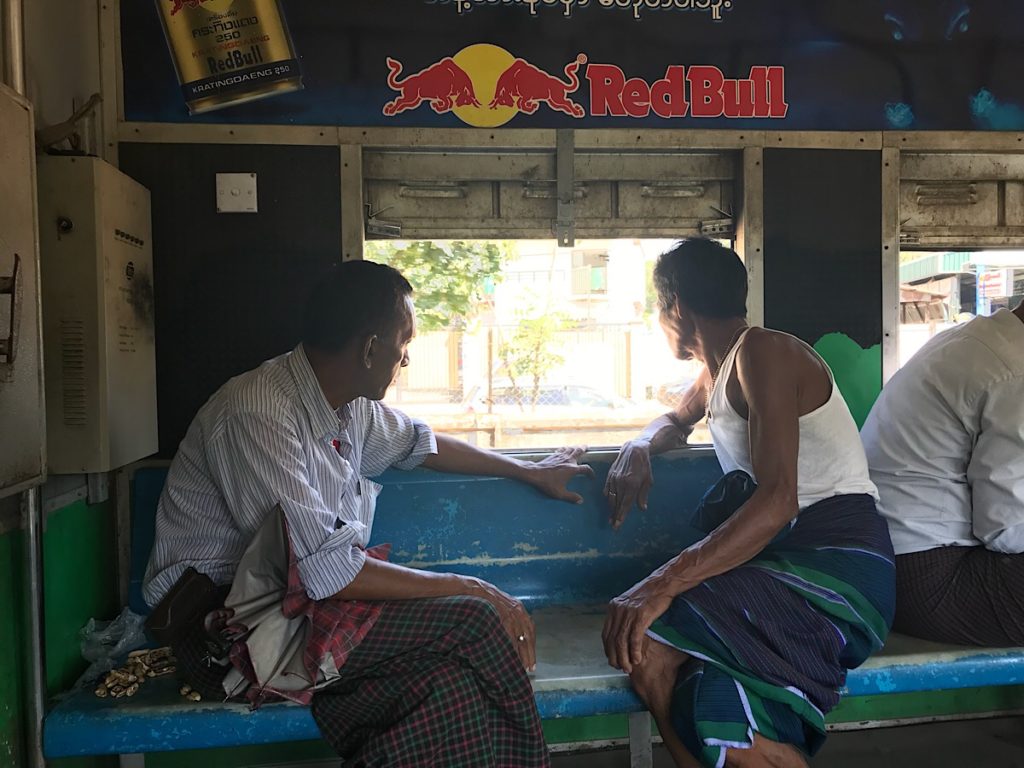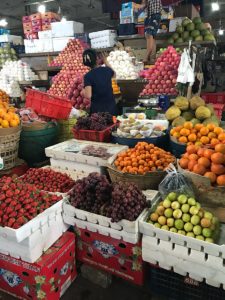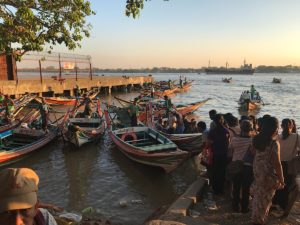Versione breve,
Yangon Yangon
Ogni volta che approdiamo in una grande città, mi sento un po’ soffocare! Mi sento sempre più rilassata in natura, ma l’immersione in Yangon e stata molto dolce! Arrivati all’aeroporto e stato facile trovare il collegamento all’albergo e arrivare al nostro piccolo confortevole ostello. Poche stanze, personale gentilissimo, bagno condivisi ma puliti e aria condizionata per fortuna! Il clima infatti è soffocante !
Siamo arrivati nel primo pomeriggio, dopo una notte di autobus per arrivare a Bangkok e salire sul nostro aereo per Yangon!
Un po’ stanchini ma decisi s non perdere il tramonto sulla Shwedagon pagoda, ci avviamo alla ricerca della pagoda più grande del Myanmar che non ci deluderà!
Il giorno dopo mercato d’obbligo… tra souvenir, pietre preziose, ombrellini, indumenti locali c’è veramente di tutto e i prezzi in generale sono ragionevoli! Più bello è il mercato delle spezie , dove si cammina tra bacelli di cannella alti un metro, altre sostanze sconosciute e moltissimi odori e colori, quasi nessuno parla inglese ma se lo fa puoi star sicuro che cercherà di conoscerti!
Comprare una scheda telefonica è molto più complicato invece ma Alvise con un po’ di pazienza ci riesce!
Il pomeriggio lo passiamo al villaggio dei pescatori , tra puzze , plastiche e baracche molto caratteristico ma un po’ triste ! Passi di lì e osservi come vivono queste persone e ti chiedi perché la loro miseria è diventata un’attrazione turistica! Questa è la Yangon moderna con shopping mall giganteschi in centro e la miseria nascosta nelle periferie! Questa è la popolazione che abita il Myanmar che è stato dominato dagli inglesi per molto tempo e da un regime oppressivo fino a poco fa, e mostra i segni della sofferenza e della rassegnazione , lo leggi sui visi della gente! Per noi è turismo ma avrei voglia di capirne di più, forse l’incontro che avremo a Mandalay con un monaco locale amico di amici ci aprirà gli occhi di più!
Il giorno dopo esperienza sul treno circolare , dovrebbe girare intorno a Yangon ma è interrotto per cui facciamo un avanti e indietro e osserviamo venditori ambulanti , soprattutto di cibo, assaggiamo anche delle frittelle dolci sotto lo sguardo sbalordito di alcuni inglesi che si rivelano testimoni di Geova venuti a indottrinare i locali… ma non potete starvene a casa vostra che col vostro atteggiamento imperialista di danni ne avete fatti già abbastanza! Il caldo e i testimoni di Geova stroncano Paola e per attenuare la mazzata ci rifugiamo al museo nazionale per addentrarci in usi e costumi.
Molto interessante e fresco, peccato che sia male illuminato! Forse i testimoni di Geova dovrebbero visitarlo per addentrarsi un po’ di più in una cultura più che millenaria.
La sera ci lasciamo trascinare dalla voglia di una birra (Paola) al 25 piano! Birra annacquata e costosa tra la bene di Yangon e qualche uomo bianco come noi! Bella la vista ma deludente l’ambiente!
Passiamo l’ultimo giorno a Yangon rilassati e rintanati nella nostra fresca camera fino al minuto del check out e poi un altro giretto al mercato ad acquistare i longyi , indumento locale costituito da un pezzo di tessuto cucito per formare un tubo, da annodare sulla vita! Unisex solo cambiano le fantasie!
Al pomeriggio ci rechiamo alla stazione per prendere il bus che in notturna ci porterà a Inle!
Yangon Yangon (short version)
Every time we land in a big city, I feel like choking! I feel more relaxed in nature, but diving in Yangon has been very sweet! Arrived at the airport it was easy to find the link to the hotel and get to our small comfortable hostel. Few rooms, very kind staff, shared bathroom but clean and air conditioning luckily! The climate is in fact suffocating!
We arrived in the early afternoon, after a night bus ride to get to Bangkok and get on our plane to Yangon!
A little tiered but we decided is not to miss the sunset on the Shwedagon pagoda, the largest in Myanmar!
The day after mandatory market … among souvenirs, precious stones, umbrellas, local wear there is really everything and prices in general are very reasonable! The spice market is nicer, there you walk among a meter’s tall cinnamon pods, other unknown substances and lots of smells and colours. Hardly anyone speaks English, but if they do, you can be sure that they will try to meet you!
Buying a phone card is much more complicated but Alvise with a little ‘patience succeeds!
We spend the afternoon at the fisherman village , among strong odours, plastics and shacks very quaint but a bit ‘sad, while walking around you observe how these people live and wonder why their misery has become a tourist attraction! This is the modern Yangon with gigantic shopping malls in the center and hidden misery in the suburbs! This is the population of Myanmar dominated by the British for a long time and by an oppressive regime until recently, and on people face’s you can read signs of suffering and resignation! For us it is tourism but I would like to understand more, perhaps the meeting we will have in Mandalay with a local monk friend of friends , will open our eyes more!
The day after we try the circular train, it should turn around Yangon but it is interrupted so we go back and forth and observe street vendors, especially food, we also taste sweet pancakes under the stunned gaze of some English people who reveal themselves as Jehovah’s Witnesses ho have come to indoctrinate the locals… why they don’t stay home ? Their imperialist attitude has done enough damage, The heat and the witnesses of Jehovah struck Paola and to mitigate the blow we take refuge in the national museum to explore habits and customs. Very interesting and cool , too bad that it is badly lit! Perhaps Jehovah’s Witnesses should visit it to get a little more into a more than a thousand-year-old culture.
In the evening we let ourselves be carried away by the desire for a beer (Paola) on the 25th floor! Watered down and expensive beer between the ‘good’of Yangon and some white man like us! Nice view but disappointing the environment!
We spend the last day in Yangon relaxed and hidden in our cool room until the minute of check out and then another visit to the market to buy the longyi, local garment consisting of a piece of fabric sewn to form a tube, to tie on the waist ! Unisex only change the patterns!
In the afternoon we go to the station to take the bus that will take us to Inle during the night!
Yangon versione estesa
moneta nazionale è il kyat cambio attuale 1000 k = o.58 euro
Day 1
Imbarco a bkk, se non avete un visto non vi lasciano fare il biglietto di imbarco . Noi abbiamo fatto un evisa per 50$ us e tutto andato bene, attenzione esistono siti che offrono e-visa e vi chiedono molti più soldi, sono intermediari con siti che si somigliano a quello ufficiale….
Arrivo aereo porto con volo nock air. Cambio valuta in aereoporto , abbiamo visto che in bkk cambiano anche la valuta Birmana quindi se mai ve ne avanzano riuscite a riconvertire. In aereoporto, fatevi dare del cambio piccolo vi servirà per il bus. Fuori della stazione molto tassisti, se siete diretti in centro prendete autobus bianco e rosso che si trova attraversando la strada in fondo sulla sinistra, panche e sedili per attesa, il trasporto pubblico è tutto marcato YBS il biglietto per il centro vi costa 500ks richiesto cambio esatto. Il bus e vi porta in centro alla stazione centrale dei treni. Il sistema di trasporto risulta piuttosto complesso, quello che abbiamo fatto è comperare una SIM card per il nostro telefono e attivare un piano. La sim 2$ e piano di 1gb altri 4 $ dopo di che si scarica la app Grab taxi e come con Uber trovi taxi molto economicamente. I tassisti pagano commissione 20% per cui se ne vedete potete offrirgli lo stesso prezzo di grab, loro ci guadagnano 20%… Grab non funziona in tutta il Myanmar nei centri più piccoli bisogna ancora contrattare.
Trovato ostello abbandoniamo i bagagli e andiamo alla scoperta di Rangoon. Prima passeggiata al parco dov’è tutte le coppiette Burmese che si incontrano e nascondono sotto ombrellini.
Il parco a una sezione con cuori, una grande scritta Love e lampioni a cuoricino, oltre che un parco giochi e istallazioni in cemento giganti da pomodori e zucchine a angurie, fun!
Poi vogliamo vedere il tramonto alla Shwedagon pagoda la più importante della città e luogo molto sacro perché contiene reliquie dei 4 Buddha che sono per ora passati sulla terra, per i buddisti deve ancora arrivare un quinto. Dell’ultimo Buddha ci sono 3 capelli che dei mercanti Burmese avevano ricevuto dal Buddha in persona per avergli dato una torta di miele.
La ricchezza della struttura è impressionate, un po’ un barocco asiatico, ovviamente come ovunque niente scarpe e vestiti appropriati per uomini e donne. Purtroppo la pagoda e parzialmente incartata per lavori di restauro, parte della pagoda e verniciata color oro ma la maggior parte e coperta in foglia d’oro o lastra d’oro.inoltre sulla parte superiore, la “campana” ci sono appesi anelli collane e orecchini donati dai devoti, più di 400kg di oro e oltre 30.000 pietre preziose tra brillanti rubini, topazi e altro anche circa 4000 campanelle di oro puro. Essendo alta oltre 100 mt i diamanti e gioielli non si vedono, ma un piccolo museo sul sito si può vedere cosa c’è. Il sito pullula di guide, turisti e devoti. Secondo tradizione buddista il giorno della settimana in cui si è nati e molto importante e in base al giorno della settimana bisogna sedersi e fare offerte, sono anche specifiche zone dove i fedeli versano acqua su statue e portano offerte. Il buddismo è da considerare più una filosofia che una religione. Atto interessante e che tsi aspetta da utti i Burmesi nel corso della loro vita di essere per un periodo dei monaci, normalmente questo avviene prima che diventino teenagers, forse meglio del servizio di leva obbligatorio che un tempo c’era in Italia.
Rientro all’ostello per dormire, andando in giro la notte tutto sembra tranquillo e pacifico a parte qualche tassista che riduce la velocità e chiede se abbiamo bisogno di un passaggio. In generale nessuno rompe le scatole anche nei mercati, non c’è neanche troppo rumore musica e casino come nelle strade del Central America. Genuinamente se vi guardare in giro e avete aria spersa persone chiedono se possono essere di aiuto e se si ha bisogno di qualcosa, on venditori e commercianti, regolari persone. L’inglese almeno nella capitale e abbastanza parlato anche da persone più anziane che hanno vissuto con dominazione inglese.
Day 1
FYI national currency is the kyat 1000k= 0.65 us$ = 0.87 cnd $
Boarding at bkk, if you do not have a visa they will not issue a boarding pass. We made a evisa for 50 $ us and all went well, beware there are sites that offer e-visa and ask you for a lot more money, they are intermediaries with sites that resemble the official one …..
Currency exchange at the airport, we have seen that in Bkk also change the Burmese currency so if you ever have any left you can reconvert, when you exchange money get some small change , you need for the bus. Outside the station a lot of taxi drivers, if you are heading to the city center take the red and white bus which is located across the street on the left, you will find some benches and you have the public transport , they are marked YBS the ticket to the center costs 500ks and required change exact to be put in a box on the bus. The bus takes you downtown to the central train station.
The transport system is rather complex, what we have done is buy a SIM card for our phone and activate a plan. The sim 2 $ and 1gb plan another 4 $ after which you download the app Grab taxi and as with Uber you find taxis very economically. The drivers pay 20% commission so what I do is show to a taxi driver the rate and if is fine with that ok, otherwise I use the app, they normally are fine as they will earn 20% more… Grab does not work in all Myanmar in smaller centers you still have to negotiate.
Found hostel we left our luggage and go to the discovery of Rangoon. First walk to the park where all the Burmese couples meet and hide under umbrellas.
The park has a section with hearts, a big Love lettering burning man style and little heart lamps, as well as a playground and installations in giant cement from tomatoes and zucchini to watermelons, fun!
Then we want to see the sunset at the Shwedagon pagoda the most important of the city and very sacred place because it contains relics of the 4 Buddhas who have for now passed on earth, for Buddhists still has to get a fifth. Of the last Buddha there are 3 hairs that Burmese merchants had received from the Buddha himself for giving him a honey cake.
The wealth of the structure is impressive, a bit ‘an Asian baroque, of course, as everywhere, no shoes and appropriate clothes for men and women. Unfortunately, the pagoda is partially wrapped for restoration work, part of the pagoda and painted in gold but most of it is covered in gold leaf or gold plate. Also on the upper part, the “bell” there are hanging rings and necklaces earrings donated by the devotees, more than 400kg of gold and over 30,000 precious stones including brilliant rubies, topazes and more even about 4000 pure gold bells. Being over 100 meters tall, diamonds and jewels are not seen, but a small museum on the site you can see what’s there. The site is full of guides, tourists and devotees. According to Buddhist tradition, the day of the week in which you are born is very important and according to the day of the week we must sit down and make offers, they are also specific areas where the faithful pour water on statues and bring offers. Buddhism is more a philosophy than a religion. Interesting thing is that Burmese in the course of their lives are expected to be a monk for a period of time , normally this happens before they become teenagers, perhaps better than the compulsory military service that once was in Italy.
Return to the hostel to sleep, going around the night everything seems quiet and peaceful except for some taxi driver who reduces the speed and asks if we need a ride. In general no one bother you even in the markets, there is not even too much noise music and mess as in the streets like Central America. Genuinely if you look around and you look lost people ask if they can help and if you need something regular people try to help you. English ,at least in the capital , is quite spoken also by older people who lived with English domination.
Day 2
Mercato tessile e di tutto di più. Siamo alloggiati alla Rangoon Boutique hotel, un ostello piccolo con camere a 20$cnd a notte posizione super centrale a due passi dal mercato e dalla stazione. Tappa obbligata a visitare il Aung San Market. Il mercato ha pietre preziose, giade e oro nella sezione centrale e più sulla periferia vestiti, scarpe, oggetti in legno, scatole in lacca. Tutto quello che un turista può volere. Anche sarte che confezionano vestiti da sposa e vestiti per ogni occasione. Sulla sezione a ovest del mercato versione locale “fast food” piatti da 400k. Il mercato ha anche un piano superiore con balconata con altri negozi , alcuni anche con bellissimi tessuti “etnici” in talmcaso i prezzi salgono. I prezzi sono molto bassi se comparati ai nostri, un longy (il “tubo” in cotone usato come gonna dalla maggior parte degli uomini) costa 7000k , una bella camicia bianca 8000k , una gonna da donna parte da 4000k tutto puro cotone prodotto in mandalay. Siamo curiosi di vedere i prezzi quando saremo la.
Passiamo poi ad un altro mercato, Theingi è a un isolato a sud se passate dal lato a ovest potete usare il sovrappasso on minor rischio di attraversare la strada è potete vedere l’incredibile contrasto con Junction City un “mall” con tutto quello che l’Occidente offre da Armani, L’Oréal , Nike, Apple etc. Il mercato risulta interessante passimomzone di riparazioni e vendita macchine da cucire, idraulici, riparatori di elettronica e finiamo alla zona tessile, in una sorta di capannoni probabilmente di età coloniale sono ammassati banchetti di venditori di tessuti, migliori di pezzo devono essere ammassate in questi banchetti che si chiudono come scatole per la notte e ogni giorno si riaprono. Turisti non se ne vedono e inglese non è sicuramente capito, una interessante esperienza.
Da questo mercato ci spostiamo a est dove troviamo il mercato delle spezie . Incredibili quantità di anacardi, cannella, cardamomo, noce moscata, noci di ogni razza tuberi e radici riempiono le bancarelle della maggior parte delle cose ignoriamo i nomi. Se ti fermi e chiedi se riescono ti dicono cosa vendono cosa serve, spesso difficile comunicare allora vicini si aggregano nelle spiegazioni. per noi una novità sono la noce di Betel. Tale noce proveniente da una palma viene abbinata a tabacco, calce e spezie. Mescolate insieme e avvolte in foglie di betel, queste sostanze vengono masticate per molte ore per favorire la digestione, profumare l’alito e migliorare l’attenzione. E far diminuire i morsi della fame, controindicazione pavimenti e strade macchiati di rosso a causa della continua salivazione e relativi sputi , cancro alla bocca e ulcere (770% rischio di contrarre tumore bocca e esofago rispetto ad un non utilizzatore, 40% degli uomini ne fanno uso e 15% delle donne) Tutto questo non ferma Burmesi (uomini e donne) a masticare e sputare. Il governo adesso cerca di ridurre la pratica vietando la vendita vicino alle scuole e vietando sputare in molti luoghi pubblici. Altra cosa che troviamo sono i tronchi thanaka. Ovunque andate vedrete sempre le donne e bambini con una polvere sulla faccia color biancastro. Tale polvere è ricavata dal legno Thanakha, un albero simile al sandalo che cresce prevalentemente nella regione del Pakoku.
Insieme al legno viene venduta anche una pietra su cui il tronchetto una volta inumidito viene strofinato, dopo un po’ si crea una pasta iallastra che viene applicato su guance sull’intero viso a mo di fondotinta. Per chi a fretta esistono versioni in vaso o polvere più velocemente applicabile. Il Tanaka non solo è per bellezza, ma soprattutto viene utilizzato come filtro solare dato che non fa passare luce, In più si dice che sia miracoloso per rendere la pelle più radiosa e splendente, proteggerla dalle impurità, eliminare le macchie e i brufoli. Qui al mercato solo tronchetti wholesale.
Per il pomeriggio programmiamo di attraversare il Yangon river e raggiungere sull’altra sponda il villaggio di Dale. Corsia preferenziale per turisti con registrazione sul solito libro che ci si domanda a cosa possa servire , pagato esorbitante cifra di 2000k per tratta, aspettiamo il traghetto che e appena partito e saliamo e in 5 minuti siamo sull’altro lato. scesi dal traghetto una miriade di guide ci aspetta riusciamo a svicolare e ci infiltriamo in una stupa, dopo poco appare una guida, abbandoniamo il colpo e lo assumiamo, 1h per 10.000k. Recupera una bici con sidecar a pedali da un locale e ci carica, per fortuna e piano e comincia a pedalare… sosta a una stupa , passaggio per villaggio pescatori dove tutti sono indaffarati con biciclette e a piedi ad andare a una grande pozza per portare a casa acqua per bere, cucinare e lavarsi. Fuori dalle case L’acqua viene immagazzinata in grosse giare in coccio smaltato. Il giro finisce vicino al mercato che ormai è finito con poco da vedere, solo gli odori ricordano quanto era sui banconi.
Giriamo ancora un po’. Forse scelta sbagliata del guidatore, quelli motorizzati si spostano più ad ampio raggio fino al vicino tempio pieno di serpenti e altri villaggi. Quando torniamo al traghetto osserviamo che sulla strada ci sono miriadi di moto e biciclette scopriamo che sono pendolari che lasciano il mezzo lì per andare a lavorare a Yangon.
Al rientro sul traghetto tutti lanciano semi e crocchette in aria miriadi di gabbiani le prendono al volo scatto un po’ di foto.
Tempo per mangiare prima di ripartire. Giriamo per la parte con bei edifici coloniali per raggiungere una. Nuova stupa, la notiamo da lontano, sembra più una giostra che un luogo religioso. Anche alla Shwedagon pagoda ogni Buddha ha dietro come aura una serie di LED che creano diversi effetti
luminosi. Sono apparsi nel 2000. Questa volta qui alla Botataung Pagoda sono andati pesanti anche su gli esterni. Biglietto ingresso 5000k, e chiude in mezz’ora quindi molliamo il colpo e decidiamo di guardare da fuori.
La pagoda sembra essere stata costruita più di 2500 anni fa! Nella seconda querela mondiale bombardata e rasa al suolo. Durante i lavori di rinnovamento incredibili scoperte archeologiche sono state fatte a supporto delle storia circa quando la stupa era stata originariamente costruita e delle reliquie in essa contenute. Rientro a ostello e riposo.
Day 2
Textile market and more. We are staying at the Rangoon Boutique hotel, a small hostel with rooms at 20 $ cnd a night super central location a stone’s throw from the market and the station. We visit the Aung San Market. The market has precious stones, jades and gold in the central section and more on the outskirts clothes, shoes, wooden objects, lacquer boxes. Everything a tourist can ask. Also seamstresses that make wedding dresses and dresses for every occasion. On the west section of the market local version “fast food” dishes from 400k. The market also has an upper floor with a balcony with other shops, some even with beautiful “ethnic” fabrics in that case prices rise. The prices are very low compared to ours, a longy (the “tube” in cotton used as a skirt by most men) costs 7000k, a beautiful white shirt 8000k, a women’s skirt starts from 4000k all pure cotton produced in mandalay . We are curious to see the prices when we will be there.
Then we move to another market, Theingi is a block south if you go from the west side you can use the overpass on less risk of crossing the road is you can see the incredible contrast with Junction City a “mall” with all that ‘West offers from Armani, L’Oréal, Nike, Apple etc. The market is interesting we walk in an area where they repairs and sales of sewing machines, plumbers, electronics and we end up in the textile area, in a sort of sheds probably colonial age are stalls of vendors of fabrics , fabrics are piled 10ft high, these stalls close up like boxes for the night and reopen every day. We do not see any tourists and English is certainly not understood, an interesting experience. From this market we move to the east where we find the spice market. Incredible amounts of cashews, cinnamon, cardamom, nutmeg, nuts, tubers and roots fill the stalls of most things we ignore the names. If you stop and ask if they can they tell you what they sell what is used for, is often difficult to communicate then neighbors aggregate in the explanations. For us, a novelty is the Betel nut. This nut is coming from a palm and is combined with tobacco, lime and spices. Stir together and wrapped in a leave, these substances are chewed for many hours to promote digestion, smell breath and improve attention. And to decrease hunger pain, contraindication is red stained floors and roads due to continuous salivation and spitting, but worst is mouth cancer and ulcers (770% risk of contracting mouth and esophagus cancer compared to a non-user, 40% of men make use and 15% of women) All this does not stop Burmese (men and women) to chew and spit. The government is now trying to reduce the practice by prohibiting sale near schools and forbidding spitting in many public places. On busses you can see sometime bags hanging in the grab handles , you can use them in case of necessity to prevent spitting in the bus. Another thing we find are the thanaka logs. You can see women and children with a powder on their faces. This powder is made from Thanakha wood, a sandal-like tree that grows mainly in the Pakoku region.
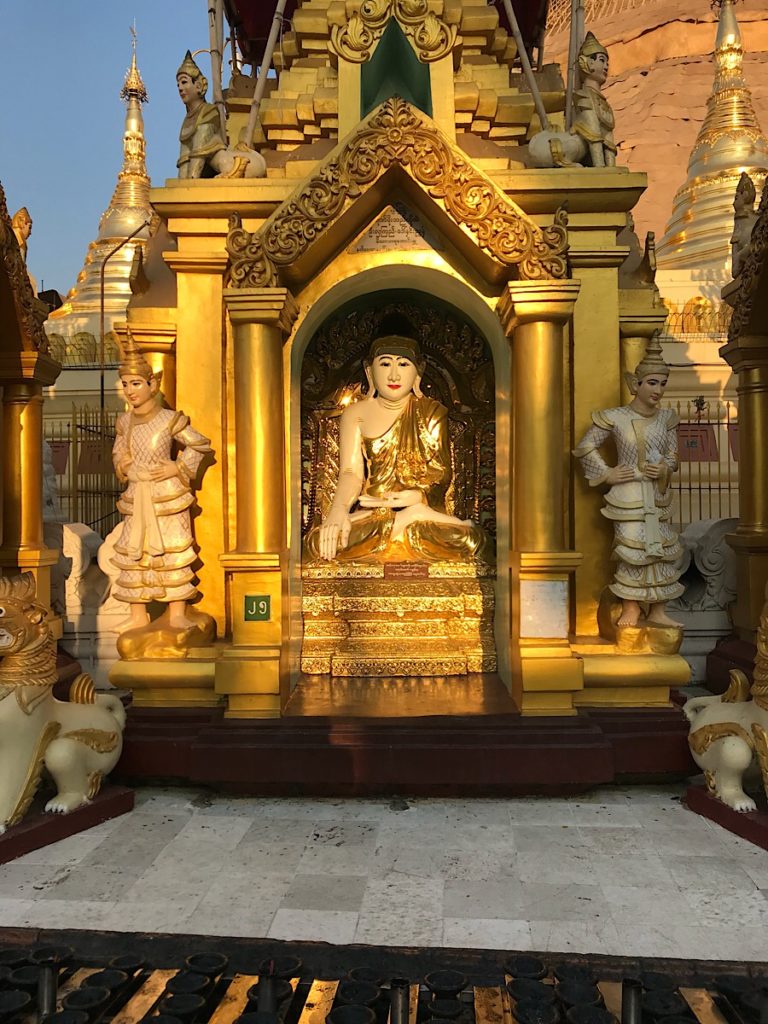
Along with the wood is also sold a stone on which the trunk , once moistened , is rubbed, after a while ‘creates an yellows paste that is applied on the cheeks or on the entire face as a foundation. For those who are in a hurry there are versions in cream or powder that can be applied more quickly. The Tanaka is not only for beauty, but above all it is used as a sun filter as it does not pass light, Moreover it is said to be miraculous to make the skin more radiant and shiny, protect it from impurities, eliminate stains and pimples. Here on the market only wholesale boots.
For the afternoon we plan to cross the Yangon river and reach the village of Dale on the other side. Preferential lane for tourists with registration on the usual book that you wonder what it can serve, paid exorbitant amount of 2000k per way, we wait for the ferry that just left and go up and in 5 minutes we are on the other side. I descended from the ferry a myriad of guides waiting for us we manage to slip and we infiltrate a stupa, after a short guide appears, we.know we will not be easy to go without one… and we hire him, 1h for 10.000k. He recover a bike with sidecar from a local and we go, fortunately and slowly and begins to pedal … stop at a stupa, passage for fishing village where everyone is busy with bicycles to go to a large pool to bring water home, to drink, to cook and to wash. Outside the houses The water is stored in large jars. The tour ends near the market that is now finished with little to see, only the smells recall what was on the counters. Perhaps we did the wrong choice of the choosing the guide on a pedal bike, the motorized ones move more widely to the nearby temple full of snakes and other villages probably worthy. When we get back to the ferry we see that on the road there are myriads of motorcycles and bicycles we discover that they are commuters who leave the vehicle there to go to work in Yangon. When they get back on the ferry, they all throw seeds and croquettes in the air. A myriad of seagulls wait for the feee food.
Time to eat before leaving. We plan to go to another stupa, we notice it from afar, it looks more like a carousel than a religious place. Even at the Shwedagon pagoda every Buddha has a series of LEDs behind it that create different lighting effects. They appeared in 2000. This time here at the Botataung Pagoda they also went heavy on the exterior. Ticket entrance 5000k, is late and they will closes in half an hour so we give up and decide to look from outside. The pagoda seems to have been built over 2500 years ago! In the second world was bombed and razed to the ground. During the renovation works, incredible archaeological discoveries were made to support the stories about when the stupa was originally built and the relics contained there. Return to hostel and rest.
Day3
Treno circolare, ma non proprio. Una delle cose consigliate in tutte le guide e prendere un treno locale che come una circonvallazione gira intorno alla città. Il treno normalmente parte ogni 30 minuti e ha un costo molto contenuto ,200k e’ molto lento e molto usato dai locali. Vive di vita propria con venditori di ogni cosa da pozioni , frittelle, frutta etc. I venditori ambulanti con merci salgono e scendono e si aggirano. Le carrozze piuttosto vetusta nelle ore di punta sono stracariche. Scopriamo che causa programma di ristrutturazione il treno funziona solo su alcune tratte e con orario modificato. È anche previsto il rimodernammento del sistema con nuove vetture ( o almeno più nuove) . Biglietto si compera al baracchino della piattaforma #6.
Prendiamo la linea a ovest per andare a visitare dei mercati di grossisti di frutta e verdura Thri Mingalar Market con i suoi odori
Scendiamo alla fermata Thiri Myaing e ci avviammo al mercato sotto un sole ormai cocente. Purtroppo siamo un po ormai in ritardo e la maggior parte dei banchetti sono spogli, montagne di verdure appassite e scarti si accumulano nelle corsie. Ancora attivo il mercato dei fiori che vengono largamente usati da tutti per offerte nei templi. Raggiungiamo anche la sezione delle banane e cocchi che erano la nostra metà, speravamo di vedere le tradizionali imbarcazioni arrivare cariche di caschi di banane ma o siamo giunti troppo tardi o siamo nel,posto sbagliato. Molti veicoli si muovono per caricare quanto probabilmente acquistato. Molti selezionano e passano cassette di frutta un po’ passata cercando di salvare il salvabile. Alcuni avocado sono giganteschi e ci sono dei pompelmi grandi quanto un melone. Molte frutte e verdure sono imballate in ceste di bambù e vimini. Soto un sole cocente molliamo la visita, decidiamo di ripararci al museo nazionale. Purtroppo l’attesa del treno risulta eterna , arriviamo al museo nazionale la cui sezione di costumi tradizionali colpisce la nostra attenzione. Anche strumenti musicali sono interessanti. Non ci accorgiamo ma arrivano le 16.00 e ci buttano fuori , ci siamo persi l’esposizione degli arredi regali che era probabilmente una delle cose più interessante. Siamo cotti quindi taxi con la applicazione Grab e hotel. Cena ad un ristorante indiano un po’ caro per gli standard locali ma molto buono. Passiamo anche a visitare il tempio indiano dedicato alla dea Kali. Molto colorTo e completamente diverso dalle stupe e pagode. Coloratissima e con statue di ogni divinità possibile. Un po’ di fedeli si aggirano con offerte e ricevendo benedizioni.
Concludiamo la giornata andando al ventesimo piano di un albergo che ha DJ e musica, LED a profusione, ingresso 5000k con una birra o soft drink, la vista non è male, bello probabilmente andare per il tramonto in alternativa a tramonti alle pagode. L’edificio e a sud della stazione centrale dei treni e ha una grande scritta CB Bank.
Day3
Circular train, but not really. One of the things recommended in all the guides is take a local train that like a ring road goes around the city. The train normally leaves every 30 minutes and has a very low cost, 200k is very slow and very used by locals. It lives its own life with sellers of everything from potions, pancakes, fruit etc. Street vendors with goods go up and down and get around. The rather old carriages at peak times are overloaded. We find out that due to the restructuring program the train works only on certain routes and with a modified timetable. It is also planned to modernize the system with new cars (or at least newer ones). Ticket shop at the platform # 6. We take the line west to visit the wholesale markets of fruit and vegetable Thri Mingalar Market (don’t expect Costco)
We go down to the stop Thiri Myaing and we started walking to the market under a burning sun. Unfortunately we are a bit late and most of the banquets are bare, mountains of withered vegetables and waste accumulate in the lanes. The flower market is still active and is widely used by all for offers in temples. We also reach the section of the bananas and coconut trees that were our half, we hoped to see the traditional boats arrive loaded with bananas but either we arrived too late or we are in the wrong place. Many vehicles move to load of stuff they probably bought. Many select and pass fruit boxes a bit ‘past trying to save the salvable. Some avocados are gigantic and there are grapefruits as big as a melons.
Many fruits and vegetables are packed in bamboo and wicker baskets. Under a scorching sun give up the visit, we decide to take shelter at the national museum. Unfortunately, waiting for the train is eternal, we arrive at the national museum whose traditional costume section hits our attention. Even musical instruments are interesting. We do not notice but time fly and is 4pm and they throw us out, we missed the display of king regalia that was probably one of the most interesting things. We are then cooked and take a taxis with the Grab app to the hotel. Dinner at an Indian restaurant a bit expensive for local standards but very good. We also pass to visit the Indian temple dedicated to the goddess Kali. Very colorful and completely different from stupas and pagodas. Colorful and with statues of every possible deity. Some believers bring offers and receive blessings.
We end the day going to the twentieth floor of a hotel that has DJ and music, LEDs in profusion, 5000k to get in with a beer or soft drink, the view is not bad, nice to probably go for sunset as an alternative to sunsets to the pagodas. The building is south of the central train station and has a large written CB Bank.
Day 4
Partenza per il lago con il pullman notturno. Il traffico è intenso quindi dobbiamo partire dal centro alle 15.00 per arrivare alla stazione autobus alle 18.00.
Facciamo i bagagli mangiamo un po’ e un ultimo giro ail vicino mercato, ce la prendiamo con calma. Rischiamo di non trovare posto su bus 2 compagnie sono sold out non troviamo i VIP bus che hanno meno sedile e file da 3 sedili quindi finiamo su un autobus 2+2 senza bagni un po’ scossone ci aspettano 12 ore di autobus… appena saliti a ognuno viene dato il suo sacchetto personale per sputare dentò il betel. Autobus di locali eccetto noi ed una giovane francese.
Day 4
We pack a bit ‘and eat, last round at the nearby market, we take it easy. We risk not finding a place on the bus 2 companies are sold out we do not find the VIP buses that have less seats and rows of 3 seats instead of 4. so we end up on a 2 + 2 bus without bathrooms , the plan is 12 hours ride…..The traffic is intense so we have to leave from the center at 3 pm to arrive at the bus station, bus is leaving at 6pm. There are letterale hundreds of busses unless you ask your taxi driver to bring exactly to the bus you plan to catch good luck.

